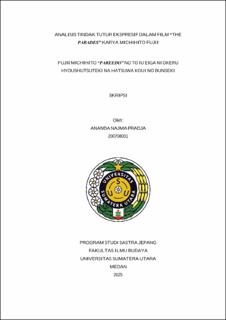Analisis Tindak Tutur Ekspresif Dalam Film "The Parades" Karya Michihito Fujii
Analysis of Expressive Speech Acts in the Movie "The Parades" by Michihito Fujii

Date
2025Author
Pradja, Ananda Najma
Advisor(s)
Hasibuan, Adriana
Arfianty, Rani
Metadata
Show full item recordAbstract
The research focuses on expressive speech acts found in the film "The Parades" by Michihito Fujii. The purpose of this research is to identify various forms of expressive speech acts, such as praising, complaining, thanking, apologizing, and congratulating, analyzed based on the context of conversations between characters in the film "The Parades" and to describe the function of each form of expressive speech act in the film. The theory used in this research is the theory of expressive speech act forms proposed by John Searle and the theory of expressive speech act functions pioneered by George Yule. The method used in this research is a qualitative method by analyzing data and describing data. The data collection technique used is library technique, and the method used is observation and note- taking. The results of this research show that the forms of expressive speech acts contained in the film "The Parades" by Michihito Fujii include praising (appearance and talent), complaining (dislike, annoyance, disappointment), thanking (for kindness), apologizing (for mistakes and failures), and congratulating (hopes and prayers). The functions of expressive speech acts include the function of hatred (dislike of behavior), liking (appreciation of appearance), difficulty (despair and regret), pleasure (gratitude and happiness), and joy (expression of frustration). Overall, the Forms of Expressive Speech Acts and Functions in the film "The Parades" by Michihito Fujii appear in interactions between character figures in the film and play an important role in conveying emotions.
Collections
- Undergraduate Theses [593]
